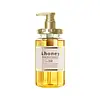What's inside
What's inside
 Key Ingredients
Key Ingredients

 Benefits
Benefits

 Concerns
Concerns

 Ingredients Side-by-side
Ingredients Side-by-side

Water
Skin ConditioningLauramidopropyl Betaine
CleansingSodium C14-16 Olefin Sulfonate
CleansingSodium Lauroyl Taurate
CleansingGlycerin
HumectantCocamide DEA
EmulsifyingTea-Lauroyl Methylaminopropionate
CleansingTea-Cocoyl Glutamate
CleansingParfum
MaskingPolyquaternium-10
Sodium Benzoate
MaskingMyristyl Betaine
CleansingPhenoxyethanol
PreservativeCitric Acid
BufferingDisodium EDTA
Polyquaternium-47
Skin ConditioningMenthol
MaskingCaramel
Cosmetic ColorantHoney
HumectantArginine
MaskingPanthenol
Skin ConditioningArgania Spinosa Kernel Oil
EmollientShea Butter Glycereth-8 Esters
CleansingButylene Glycol
HumectantGluconobacter/Honey Ferment Filtrate
Skin ConditioningPPG-7
Skin ConditioningAcacia Senegal Gum
MaskingHoney Extract
HumectantCoco-Glucoside
CleansingKeratin
Skin ConditioningHydrolyzed Honey Protein
Skin ConditioningRoyal Jelly Extract
Skin ConditioningPaeonia Officinalis Flower Extract
TonicPropolis Extract
Skin ConditioningHydrolyzed Silk
HumectantHydroxypropyltrimonium Hyaluronate
Methylchloroisothiazolinone
PreservativeMethylisothiazolinone
PreservativePotassium Sorbate
PreservativeMagnesium Nitrate
Magnesium Chloride
Water, Lauramidopropyl Betaine, Sodium C14-16 Olefin Sulfonate, Sodium Lauroyl Taurate, Glycerin, Cocamide DEA, Tea-Lauroyl Methylaminopropionate, Tea-Cocoyl Glutamate, Parfum, Polyquaternium-10, Sodium Benzoate, Myristyl Betaine, Phenoxyethanol, Citric Acid, Disodium EDTA, Polyquaternium-47, Menthol, Caramel, Honey, Arginine, Panthenol, Argania Spinosa Kernel Oil, Shea Butter Glycereth-8 Esters, Butylene Glycol, Gluconobacter/Honey Ferment Filtrate, PPG-7, Acacia Senegal Gum, Honey Extract, Coco-Glucoside, Keratin, Hydrolyzed Honey Protein, Royal Jelly Extract, Paeonia Officinalis Flower Extract, Propolis Extract, Hydrolyzed Silk, Hydroxypropyltrimonium Hyaluronate, Methylchloroisothiazolinone, Methylisothiazolinone, Potassium Sorbate, Magnesium Nitrate, Magnesium Chloride
 Reviews
Reviews

Ingredients Explained
These ingredients are found in both products.
Ingredients higher up in an ingredient list are typically present in a larger amount.
Glycerin is already naturally found in your skin. It helps moisturize and protect your skin.
A study from 2016 found glycerin to be more effective as a humectant than AHAs and hyaluronic acid.
As a humectant, it helps the skin stay hydrated by pulling moisture to your skin. The low molecular weight of glycerin allows it to pull moisture into the deeper layers of your skin.
Hydrated skin improves your skin barrier; Your skin barrier helps protect against irritants and bacteria.
Glycerin has also been found to have antimicrobial and antiviral properties. Due to these properties, glycerin is often used in wound and burn treatments.
In cosmetics, glycerin is usually derived from plants such as soybean or palm. However, it can also be sourced from animals, such as tallow or animal fat.
This ingredient is organic, colorless, odorless, and non-toxic.
Glycerin is the name for this ingredient in American English. British English uses Glycerol/Glycerine.
Learn more about GlycerinPanthenol is a common ingredient that helps hydrate and soothe the skin. It is found naturally in our skin and hair.
There are two forms of panthenol: D and L.
D-panthenol is also known as dexpanthenol. Most cosmetics use dexpanthenol or a mixture of D and L-panthenol.
Panthenol is famous due to its ability to go deeper into the skin's layers. Using this ingredient has numerous pros (and no cons):
Like hyaluronic acid, panthenol is a humectant. Humectants are able to bind and hold large amounts of water to keep skin hydrated.
This ingredient works well for wound healing. It works by increasing tissue in the wound and helps close open wounds.
Once oxidized, panthenol converts to pantothenic acid. Panthothenic acid is found in all living cells.
This ingredient is also referred to as pro-vitamin B5.
Learn more about PanthenolPhenoxyethanol is a preservative that has germicide, antimicrobial, and aromatic properties. Studies show that phenoxyethanol can prevent microbial growth. By itself, it has a scent that is similar to that of a rose.
It's often used in formulations along with Caprylyl Glycol to preserve the shelf life of products.